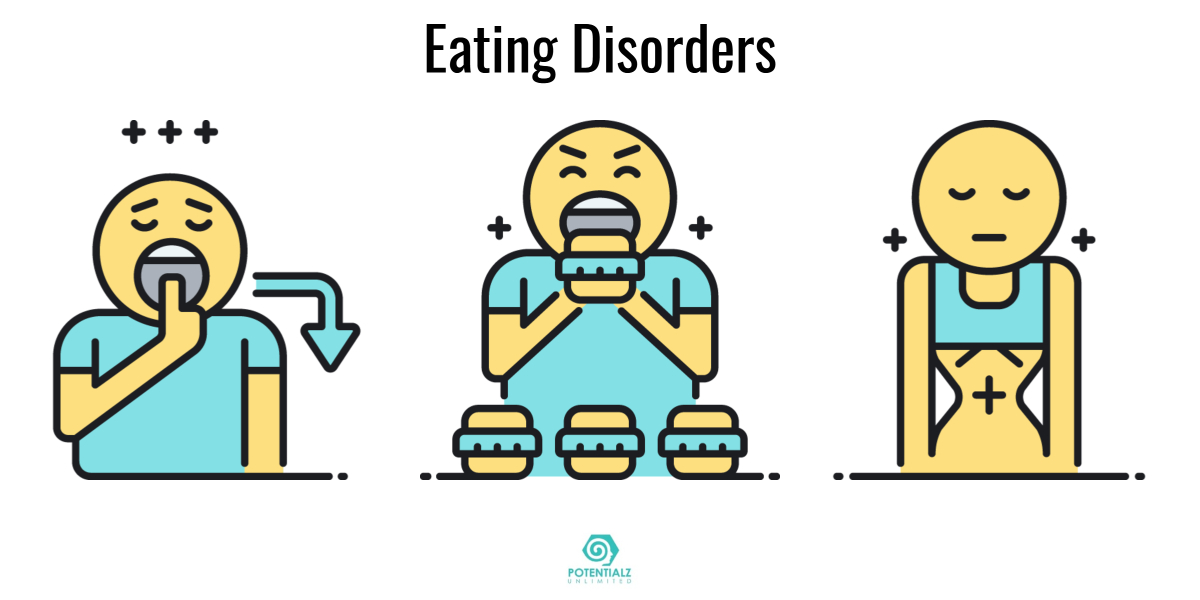“Dying To Be Thin?”

An eating disorder is a disturbance in eating behavior that compromises a person’s physical and psychological health. Anorexia nervosa and Bulimia are chronic problems in which there is a preoccupation with food, eating and weight loss.
Eating disorders are a very dangerous type of illness no matter who you are. Men also get eating disorders. More and more young men are coming forward and admitting their obsessions with their weight and food, one of them wrote to us, he wanted to share his situation with others, his story will appear at the end of this article soon.
Anorexia Nervosa
Just What is It?
 Anorexia nervosa was first described in scientific literature over a hundred years ago in England. Descriptions of self-starvation have even been found in medieval writings. Anorexia is not a new syndrome that the media has created, but has certainly influenced. Anorexia nervosa is a self-starvation syndrome in which a person willingly loses an excessive amount of weight (20% or more of their original body weight), shows muscle wasting, suffers from body image disturbances and experiences intense fears about becoming fat, no matter how thin the individual becomes. The term “anorexia”, literally meaning loss of appetite, is deceiving; since hunger is felt by the anorexic person. In the case of anorexia the hunger pains are denied. Despite their refusal to eat, people with anorexia become obsessed with food, often fantasizing about it, reading recipes or cookbooks and often preparing large meals for others.
Anorexia nervosa was first described in scientific literature over a hundred years ago in England. Descriptions of self-starvation have even been found in medieval writings. Anorexia is not a new syndrome that the media has created, but has certainly influenced. Anorexia nervosa is a self-starvation syndrome in which a person willingly loses an excessive amount of weight (20% or more of their original body weight), shows muscle wasting, suffers from body image disturbances and experiences intense fears about becoming fat, no matter how thin the individual becomes. The term “anorexia”, literally meaning loss of appetite, is deceiving; since hunger is felt by the anorexic person. In the case of anorexia the hunger pains are denied. Despite their refusal to eat, people with anorexia become obsessed with food, often fantasizing about it, reading recipes or cookbooks and often preparing large meals for others.
 Anorexia is still more prevalent in young women than in young men. The disorder typically begins in teenage women who are either overweight or perceive themselves that way. An interest in weight reduction becomes an obsession with severely restricted caloric intact and, often excessive physical exercise. Teasing by peers or parents can also play a role in the fear of becoming overweight.
Anorexia is still more prevalent in young women than in young men. The disorder typically begins in teenage women who are either overweight or perceive themselves that way. An interest in weight reduction becomes an obsession with severely restricted caloric intact and, often excessive physical exercise. Teasing by peers or parents can also play a role in the fear of becoming overweight.
Many teenagers who suffer from anorexia have a fear of becoming an adult, and so try to maintain the figure of a child. Low self-esteem, feelings of shame and guilt, and problems with drug and or alcohol abuse may also contribute to this disorder.
Complications
 Many organ systems are affected by the malnutrition that occurs in people with anorexia. The severity of the abnormalities tends to be related to the degree of malnutrition and reversed with re-feeding. The most frequent complication of anorexia is amenorrhoea (cessation of menstruation), and the loss of secondary sex characteristics with the decreased levels of estrogen that anorexia nervosa causes. Other complications include; constipation, cold intolerance, slow heart rate, low blood pressure, decreased heart size, irregular heart beat, dry skin, and hair loss. Unexpected sudden deaths have been recorded. The risk of death appears to increase as weight drops to less than 35% to 40% of ideal weight. It is believed that these deaths are due to heart failure.
Many organ systems are affected by the malnutrition that occurs in people with anorexia. The severity of the abnormalities tends to be related to the degree of malnutrition and reversed with re-feeding. The most frequent complication of anorexia is amenorrhoea (cessation of menstruation), and the loss of secondary sex characteristics with the decreased levels of estrogen that anorexia nervosa causes. Other complications include; constipation, cold intolerance, slow heart rate, low blood pressure, decreased heart size, irregular heart beat, dry skin, and hair loss. Unexpected sudden deaths have been recorded. The risk of death appears to increase as weight drops to less than 35% to 40% of ideal weight. It is believed that these deaths are due to heart failure.
Treatment
The most difficult part of treating the anorexic person is the inability of the person to realize that there is indeed a problem. Since anorexia is a form of starvation, it can lead to death if left untreated.
Research suggests that anorexics can achieve weight gain by way of treatment, although they may never reach ideal weight. Frequently their abnormal eating patterns of avoiding high calorie foods continues. There is no preferred single form of treatment. Psychological interventions are often helpful. Initially, anorexia was thought to be a psychological problem, but in the past several years scientists have discovered that people with eating disorders have a chemical imbalance in the brain similar to those found in people with depression.
Bulimia
What is Bulimia?
 Bulimia is an eating disorder that has several distinctive behaviors, feeling and thoughts. Bulimia, (a term that literally means “ox hunger”), is characterized by secretive episodes or “binges” of eating large quantities of high-calorie, high carbohydrate, easy-to-eat foods, such as ice cream, cookies, or donuts. There are also periods of severe food restriction by way of dieting or vomiting to prevent weight gain. The purging behaviors are what distinguish it from anorexia. Purging behaviors include self-induced vomiting, use of diuretics, use of laxatives to induce diarrhea and or obsessive exercise.
Bulimia is an eating disorder that has several distinctive behaviors, feeling and thoughts. Bulimia, (a term that literally means “ox hunger”), is characterized by secretive episodes or “binges” of eating large quantities of high-calorie, high carbohydrate, easy-to-eat foods, such as ice cream, cookies, or donuts. There are also periods of severe food restriction by way of dieting or vomiting to prevent weight gain. The purging behaviors are what distinguish it from anorexia. Purging behaviors include self-induced vomiting, use of diuretics, use of laxatives to induce diarrhea and or obsessive exercise.
People who experience the binge-purge syndrome are usually women in their late teens through the mid-thirties. Their weights may fluctuate, but not to the dangerous low levels seen in people with anorexia nervosa. The thoughts and feelings of people with bulimia range from fear of not being able to stop eating to a concern about gaining too much weight. They also experience feelings of sadness, anger, guilt, shame and low self esteem. In contrast to anorexic persons, who turn away from food when facing problems, bulimic persons turn towards food. Also unlike anorexic persons, they do recognize that their behavior is abnormal.
People with bulimia nervosa tend to lead secret lives, hiding their abnormal eating habits. In a single binge they can consume foods supplying 10,000 to 15,000 calories or more. The binge usually occurs in several stages: anticipation and planning, anxiety, urgency to begin, rapid and uncontrollable consumption of food, relief and relaxation, disappointment and finally shame.
Complications
The complications of binge-purge syndrome include those resulting from overeating, self-induced vomiting, and diuretic and laxative abuse. Among the complications of binge-purge syndrome are dental disorders, body fluid disorders, and salivary gland problems. Dental abnormalities, such as sensitive teeth, dental decay and gum disease occur from the frequent vomiting. This is due to the high acid content of vomit, it eats away at the tooth enamel and sometimes teeth are lost as a result. Use of laxatives changes normal bowel patterns. Diuretics can throw off a person’s acid-base balance.
REMEMBER: Self-induced vomiting can lead to swelling of salivary glands, electrolyte and mineral disturbances, and enamel erosion in teeth. Laxative abuse can lead to long lasting disruptions of normal bowel functioning. Complications such as tearing the esophagus, rupturing the stomach, and developing life-threatening irregularities of the heart rhythm may also result.
Treatment
 The treatment requires a team of experienced clinicians. Therapists aim to reduce the number of binge-purge episodes by improving self-acceptance, decreasing concern about body weight and altering abnormal attitudes. The primary goal of therapy for this syndrome is to establish a regular healthful eating pattern. Unlike those who suffer with anorexia nervosa, the person with bulimia is upset by the behaviors they are exhibiting and by the and thoughts that they experience. This makes them more likely to accept help for their disorder. People who have been successfully treated for bulimia seem to have benefited from making meal plans, avoiding high sugar foods or binge foods, exercising regularly, finding alternative activities, and from behavioral or traditional psychotherapy.
The treatment requires a team of experienced clinicians. Therapists aim to reduce the number of binge-purge episodes by improving self-acceptance, decreasing concern about body weight and altering abnormal attitudes. The primary goal of therapy for this syndrome is to establish a regular healthful eating pattern. Unlike those who suffer with anorexia nervosa, the person with bulimia is upset by the behaviors they are exhibiting and by the and thoughts that they experience. This makes them more likely to accept help for their disorder. People who have been successfully treated for bulimia seem to have benefited from making meal plans, avoiding high sugar foods or binge foods, exercising regularly, finding alternative activities, and from behavioral or traditional psychotherapy.
Can you help a friend who is in denial? It is very hard to get them to see what they are doing.
A teen reader who is bulimic and in treatment wanted to share one day of her “food diary” with us.
FOOD DIARY of a Bulimic Female Teenager,- Age 16
| 7 a.m. | 1 slice toast, plain |
| 1 cup of coffee, black | |
| 1 cup bran cereal with 1/2 cup skim milk |
| Noon | One large salad with no dressing, but lemon juice |
| 1 diet cola |
| 6 p.m. | Weight Watchers frozen dinner |
| 1 diet soda |
| 10 p.m. | 2 bags of cookies |
| 6 chocolate glazed donuts | |
| 1 pint of ice cream | |
| 1/2 loaf of garlic bread with butter | |
| 1 large bag of corn chips | |
| 10:30 pm | * Self-induced vomiting * |
Summary
The most crucial thing about treating eating disorders is to recognize and address the problem as soon as possible. Unhealthy eating patterns become harder to break the longer a person takes part in them. If you or someone you know has an eating disorder, get help. Anorexia and bulimia can do a lot of damage to the body and mind if left untreated. Remember, they can both kill. Even if a person recovers fully from this disorder, serious permanent damage may have already been done to the body. The scope of related problems associated with eating disorders highlights the need for prompt treatment and intervention.
For sufferers: Admitting you have an eating, exercise, or body image problem that requires treatment is difficult. Taking those first steps to seeking help are filled with fear, anxiety, but also HOPE. Finding and getting the right help is essential. There are a variety of treatment options available: individual therapy, group therapy, nutritional support, psychiatric care, outpatient, inpatient, and even residential treatment facilities.
- Answer these questions for yourself in privacy…
- Check out When Dieting Becomes Deadly: An Introduction to Eating Disorders. This article is very informative!
- Do you think you or a friend is at risk for an ED? Answer these questions for yourself or for them…
- See Self-esteem in ALL sizes! and Self-esteem
Resources on the web and phone referrals for eating disorders:
Try our list of “mind matters” links — for professional and personal websites.
Something Fishy – Probably the best eating disorder site on the web!
Eating Disorder Referral and Information Center
Phone: 858-792-7463
S.C.A.R.E.D. – Support, Concern and Resources For Eating Disorders. Provides a variety of information about the various eating disorders and related issues effecting lives all over the world. Resources and information from the net, a message forum, mailing lists, support and understanding. A special section just for teens.
The Center for Eating Disorders
Examine your own situation by taking our short quiz. Read about eating disorders. Join the discussion group. Or send a private message to one of the physicians at the Center for Eating Disorders.
Eating Disorders Awareness and Prevention
1-800-931-2237 (Hours: 8am-noon daily, PT)
Eating Disorders Center
1-888-236-1188
National Association of Anorexia Nervosa
1- 847-831-3438
National Anorexic Aid Society
1-614-436-1112
Recommended Reading, click on image for more info or to order:

Stick Figure: A Diary of My Former Self Teen Health Secrets
by Lori Gottlieb – From the diaries she kept as an 11-year-old, the author’s wry, perceptive account of her near-fatal struggle with anorexia nervosa is told with an unguarded openness not seen since Susanna Kaysen’s Girl Interrupted. Stick Figure has been option for film by Martin Scorsese’s De Fina/Cappa Productions.

Am I Thin Enough Yet?: The Cult of Thinness and the Commercialization of Identity Teen Health Secrets – In “one of the most powerful and compelling arguments about the culture of thinness, the former director of the Women’s Studies Program at Boston College highlights the various ways in which American families, schools, popular culture, and the health and fitness industry undermine young women’s self-confidence as they inculcate the notions that thinness is beauty and a woman’s body is more important than her mind.

Anatomy of Anorexia – by Steven Levenkron

The Golden Cage: The Enigma of Anorexia Nervosa
– by Hilde Bruch. MD — One of the world’s leading authorities offers a vivid and moving account of the causes, effects, and treatment of this devastating disease.
